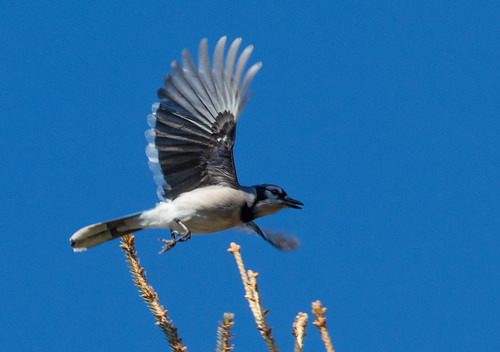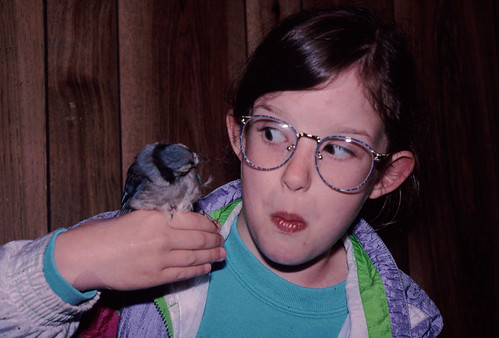This week we inaugurated a new, interactive feature on For the Birds, allowing listeners to call or send in a brief sound file saying what their favorite bird is. And since it is National Blue Jay Awareness Month, it’s hardly surprising to hear from this caller:
This is me, Jim Baker. My favorite bird is the Blue Jay because DUH! The Blue Jay is Nature’s Perfect Bird. And if you want to attract Blue Jays to your feeders, instead of all the riff raff of the bird world, get the bird feed rocket scientists recommend most, Baker’s Blue Jay Blend. Available only at Baker’s Blue Jay Barn, “Up the Shore a Ways.”I googled to see if any recent research about Blue Jays has made the news, but the only story I could find was about the Toronto Blue Jays, which hit a mere 5 triples in 2017, a record low for any team in any season, including in strike years. An all-time record for any kind of Blue Jay is certainly an interesting fact, though not quite what I was looking for. With a more sophisticated search, I came across the fact that a Blue Jay banded in Newfoundland in 1989 was found dead, caught in fishing gear, in 2016, when it was at least 26 years, 11 months old, shattering the longevity record for Blue Jays by over 9 years.
There may not be any other recent research breakthroughs about Nature’s Perfect Bird, but a long history of Blue Jay research has taught us a lot. I often hear from people who think Blue Jays are bullies at feeders, but those people are misinterpreting what they see. Songbirds scatter when a Blue Jay flies in, in part because the shape, with rounded wings and a long tail, is just close enough to that of a Sharp-shinned Hawk that no sensible bird wants to linger a split second to verify the identification.
Sometimes Blue Jays make a Red-shouldered Hawk cry or other predator call before flying in, too. For one brief, shining moment when they land in the feeder, they have it all to themselves.
But once they’re eating, Blue Jays are not very assertive. In a study at Florida bird feeders, Red-headed Woodpeckers, Florida Scrub-Jays, Common Grackles, and gray squirrels strongly dominated Blue Jays, often preventing them from obtaining food. The jays have a longer reach than tinier birds, but are no more bullies against goldfinches than other goldfinches are. Their crest pops up when they’re being aggressive in territorial defense, protecting their families, or squawking because they just saw some form of danger. They usually keep the crest down while dining.
Blue Jays are among the most intelligent of birds, but are much harder to study in the wild than the more sedentary Gray Jay and Florida Scrub-Jay. Blue Jays are certainly noisier—they could squawk their heads off all day without scaring away their favorite food—acorns. The quieter, sneakier jay species eat much more meat. One strategy the Gray Jay and Florida Scrub-Jay share for getting meat is to steal it from larger animals. They are so quiet when they see large mammals, such as humans, because they want to sneak in and steal our food.
All jays sometimes raid songbird nests to take eggs or young. Most species eat the plunder themselves as well as feeding it to their young. Fully 88 percent of a Gray Jay’s food is animal-based. You can't see Gray Jays in late spring and early summer without lots of littler birds anxiously trying to chase them away. But an adult Blue Jay’s diet is 88 percent plant-based, so it doesn't need to eat baby birds. Its rapidly growing babies do need animal protein, so virtually every bit of the baby birds a Blue Jay steals goes to feeding its hungry nestlings. Meanwhile, the Blue Jay habit of squawking conspicuously at potential predators provides an important neighborhood watch service for the whole community, so other songbirds never trying to chase a Blue Jay away unless it’s actively approaching a nest.
So Blue Jays are not as bad as some people think, and of all the birds in the known universe, they're the only one about which Mark Twain wrote an entire story, "Baker's Blue Jay Yarn." For the past 30 years, For the Birds' own Jim Baker (voiced by my treasured friend John Keenan) has been helping me share that connection between Blue Jays and good humor. Whether it's National Blue Jay Awareness Month or not, it's always a good time to smile, and Blue Jays can give us plenty of reasons for that.


